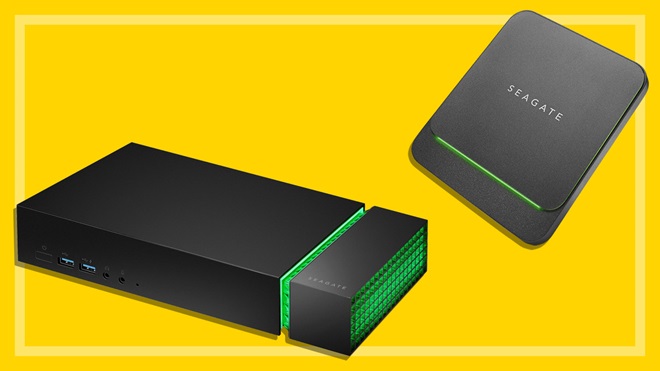CHOICE verdict
Seagate’s new releases are all about fast external storage and connectivity for gamers, but these devices could serve a home-office set-up just as well. The Barracuda Fast SSD is a highly-pocketable SSD (solid-state drive) for on-the-go users. The FireCuda Gaming Dock is a colourful desktop companion with a 4TB (terabyte) hard drive with the option for an extra built-in high-performance SSD for super-swift storage. It has all the ports you should need for connecting multiple displays and other devices. The dock is ideal for gamers or anybody setting up a home office, but you’ll need Thunderbolt 3 on your laptop or PC.
Price: Seagate BarraCuda Fast SSD 500GB ($169); 1TB ($289) and 2TB ($599); FireCuda Dock $599
Contact: seagate.com/au/en

The Barracuda SSD, seen here attached to a laptop via USB-C (Gen2), is small and slim but provides fast access to plenty of data.
We put both devices through their paces courtesy of Seagate and found they could be a very useful addition to anybody's desk, if you have the right connection ports.
Barracuda Fast SSD
The palm-sized Barracuda Fast SSD has the advantage of a USB 3.1 Gen2 Type-C port (rated at double the speed of the standard USB-C port). It's formatted as exFAT, so it's compatible with Windows and Mac PCs and includes software tools for backup and sync. It's a small but swift and very handy pocket drive that comes in three capacities: 500GB ($169); 1TB ($289) and 2TB ($599).
FireCuda Gaming Dock
Want the convenience of connecting all your devices to your computer with just one cable? The FireCuda Gaming Dock gives you that, plus a big hard drive (HDD) and the option of super-fast solid-state storage as well.
It has a built-in 4TB desktop hard drive (3.5") for plenty of capacity for data storage and archiving games, but it's the SSD expansion slot that makes it extra special. This slot takes an optional solid-state storage add-on – a PCIe Gen3 NVMe M.2 SSD card, available in various capacities.
You'll need Thunderbolt 3 on your laptop or PC
To use the dock, you must plug it in using its large power brick, and then connect it to a laptop with a Thunderbolt 3 (USB-C) connection. It won't work optimally on a laptop that doesn't have Thunderbolt 3. The Thunderbolt 3 connection will allow power, display, USB, Ethernet, and audio signals to pass through the dock from the laptop.
Single plug and play
A monitor, ethernet cable, USB mouse and keyboard, speakers or headset, and a microphone, can all be connected to the dock permanently, so when you need to use your laptop as a desktop computer, you can just plug in the USB-C cable and all the peripherals that are attached to the dock will be available.
The interface for a monitor is DisplayPort (1.4); there are five USB 3.1 (Gen2) ports (three on the rear and two in the front), as well as two USB-C Thunderbolt 3 ports, one of which is needed as the main connection to your laptop. Gigabit ethernet is on the rear, while audio jacks are on the front.

The front of the dock gives handy access to two USB ports plus separate headphone and microphone ports. The right-hand side cover is removable to provide access to the optional super-fast SSD card.

The rear of the dock offers three more USB ports plus ethernet, DisplayPort and two USB-C Thunderbolt 3 ports (one of which connects to your computer, but the other can daisy-chain multiple devices). A tiny firmware update button sits between the two. The power connector is at far left.
High performance
Seagate, being a storage company, sells this dock with a 4TB hard drive built in. This means that the dock is not only useful as a connection point for peripherals, but also as external storage. In testing we found it was able to read at 274MBps (megabytes per second), and write at 259MBps. These are fast figures for a hard drive. Of course, once it is full of data it will slow down a bit, as all hard drives do.

Remove the end cover and slot in a FireCuda PCIe Gen3 NVMe M.2 SSD card for some super-fast storage.
If performance is your thing (and it likely will be if you buy this dock), you can install an NVMe-based (not SATA) SSD into the M.2 slot in the dock. The NVMe drive needs to be of the 2280 size, which refers to it being 22mm wide and 80mm long. Note that though you can also buy 2230-sized drives, they aren't supported by this dock due to the mounting screw.
An LED is illuminated via the removable cover on the right side of the dock (viewed from the front) and pulses slowly by default. Seagate Toolkit software gives you control over the colours and light patterns created by the LED, though our experience of this was limited in our hands-on trial.
Toolkit also allows you to backup and restore data using the dock's hard drive as the backup space, and there is also a Mirror setting, which allows you to duplicate the contents of a designated folder on your laptop to the hard drive, which is very handy.

The FireCuda Dock can be the centrepiece of fully-connected desktop setup.
We're on your side
For more than 60 years, we've been making a difference for Australian consumers. In that time, we've never taken ads or sponsorship.
Instead we're funded by members who value expert reviews and independent product testing.
With no self-interest behind our advice, you don't just buy smarter, you get the answers that you need.
You know without hesitation what's safe for you and your family. And our recent sunscreens test showed just how important it is to keep business claims in check.
So you'll never be alone when something goes wrong or a business treats you unfairly.
Learn more about CHOICE membership today
Stock images: Getty, unless otherwise stated.



